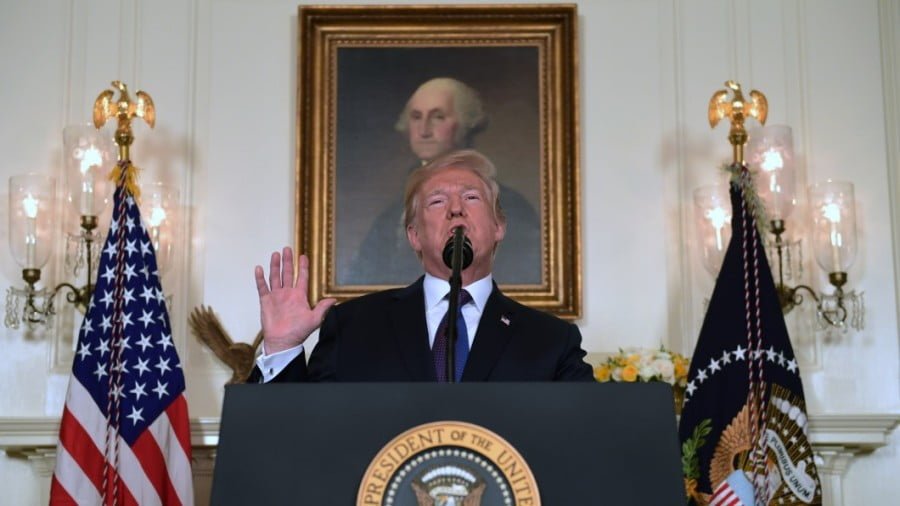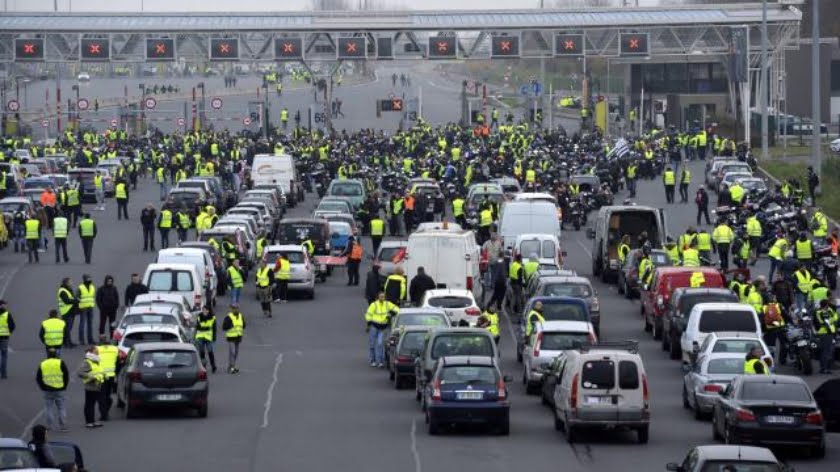Trump’s ‘Mission Accomplished’ Tweet May Come Back to Haunt Him
Syrian army troop reinforcements are moving up to more front lines in the suburbs of Damascus for another battle which could prove to be a carbon copy of the Douma siege.
Just as some fighters accepted Russian military mediation to leave Eastern Ghouta two weeks ago, while others stalled and held out to the end – when footage of gassed civilians went around the world and led to last week’s Anglo-American and French air strikes in Syria – Russian and Syrian government negotiations to end the battles for the Yarmouk Camp have largely succeeded.
But in an area on the edge of the old Palestinian camp district called al-Qadam, where civilians are still living, Isis and other jihadis are refusing to depart; so fresh Syrian troops and Palestinian militias from the ‘Al Quds’ Brigade are being sent to the suburb in preparation for a final battle if the talks drag on. Donald Trump’s triumphal claim at the weekend to have taught Syrian president Bashar al-Assad a lesson will look more than ironic if yet more images of choking civilians then appear on tape.
Explosions from the area were thundering across Damascus on Sunday when state radio reported that seven mortar shells fell onto government-held areas, killing one civilian and wounding nine others. But what makes this particular battleground so perilous is the anger caused by a massacre – one so dreadful that the Syrian authorities did not reveal it – when 120 Syrian soldiers were executed during a truce agreement arranged with Isis-allied gunmen almost three weeks ago. The mass killings occurred on 27 March after 500 Syrian troops entered a ceasefire line at al-Qadam which they believed to be safe. Surrounded, many of the Syrians escaped, but 116 of them were captured.
The prisoners, both army intelligence officers and ordinary soldiers, were apparently led away to a street where all were systematically murdered, some of them shot, others beheaded. The slaughter was kept secret by state television and government newspapers because of the effect it might have on the families of the dead men. Poor but terrifying images I have watched – apparently of the massacre and briefly appearing on the Isis website Amaq – show a line of troops, most of them in battle uniform, some of them still wearing steel helmets, being led across waste ground to a street. As the killers – in black uniforms and holding Kalashnikov rifles – begin to shoot down the men, the soldiers can be heard shouting “No! No! No!” as bullets are fired into them. A pile of bodies can be seen behind them in other footage.
The Syrian Red Crescent later removed 96 of the corpses, but 30 of the dead men were unaccounted for. The story – similar to Isis killings in the Palmyra Roman theatre earlier in the war – has outraged the army and the individual families of those who were executed. I know of one man whose cousin, a soldier, was among the murdered men.
This is the area which may now be the site of the next battle for the Syrian suburbs. The Isis footage, whose date cannot be confirmed, does not contain the murder of civilians; the pictures are thus not as pitiful as the gas-choked women and children of Douma which caused such international outrage. But this is the area in which the next battle for Damascus may well be fought.
And it raises a horrible question. If the final al-Qadam ceasefire talks – in which the Russian army are deeply involved – fail, will the world see even more pictures of besieged civilian gas victims dying in agony? More to the point, what will Trump, Prime Minister Theresa May and French President Emmanuel Macron do then? Will further missile strikes have to be staged all over again?
It’s always dangerous to think a foreign nation can switch off its involvement in a war because it doesn’t wish to undertake further military operations. And it’s especially difficult when the conflict is a civil war. Western public opinion might tolerate one dangerous adventure – after not a single life was lost and individual targets were apparently hit with accuracy. But not another one.
The Syrian government insists that the rubble in Damascus was once a “centre of scientific research” with no connection to chemical weapons, although the very name has a rather Strangelove quality about it. And requests made by The Independent to visit the ruins of the building hit by missiles at Barzeh, less than two miles from the centre of the city, were officially declined on Sunday, although photographs of the building have been printed in the Damascus press. Thousands of Damascenes watched the missiles – and the Syrian anti-aircraft fire – flashing across the darkened sky of the city in the early hours of Saturday morning. The explosions lasted for around 12 minutes according to seven separate witnesses to whom I spoke. One said they counted 116 rockets.
The Syrian military have focused on the abilities of their anti-aircraft missile crews, which are reported by both the Syrian and Russian governments to have brought down 71 missiles before they could hit their targets. The US denies such claims. The Syrian army have been collecting parts of the exploded US weapons, and little attempt is made to hide the fact that their details are being shared with their allies – obviously, Russia and Iran. They also claim unofficially that their own anti-aircraft fire prevented the Americans from shooting at another six targets which were not destroyed. This may be what one often refers to as a likely story.
But the next battle is now beginning to dominate the thoughts of the military authorities in Damascus. The Yarmouk area and al-Qadam and the neighbouring Hajr el-Aswat have been the scene of fighting, with thousands of civilians under siege, for years – just as Eastern Ghouta, which contains Douma, was until the past two weeks. There are an estimated 2,000 fighters still under arms there, perhaps half of them Isis operatives. Two smaller Islamist groups have already agreed with the Russian army to be bussed out on the long trek to Idlib province, the dumping ground for most of the Syrian regime’s armed opponents and their families.
But if talks drag on – and Syrian and Russian leaders lose patience – then the prospect of another Douma in al-Qadam becomes more likely. At which point, Trump’s ‘mission accomplished’ could turn out to be as ironic as George W Bush’s identical and fatuous claim after the 2003 invasion of Iraq.







